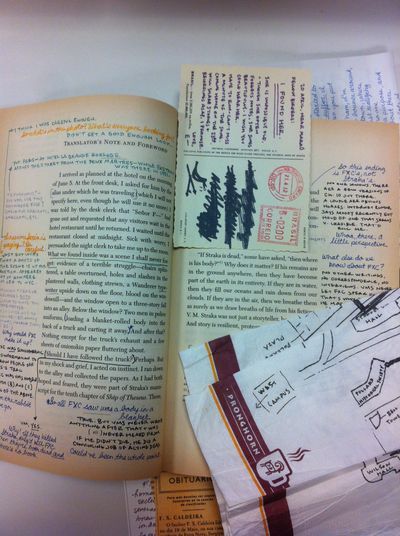The e-book made real
J. J. Abrams, the creator of Lost
(that “theological”, “mythological”, “numerological”, “dualistic”,
“apocalyptic”, popular TV series) has “conceived” of a book. Doug Dorst has
actually written it and Canongate have duly published.
B. S. Johnson’s novel in a box The Unfortunates, both Nabokov’s Pale Fire and The Original of Laura, the study of marginalia, Tom Phillips's book-as-art Humument – these might all be seen as influences on Abrams’s conception. But in
fact, he says, he “conceived” of S simply when he found an abandoned book in an
airport, annotated with a note to the future reader.
Here is the shape of his realized
conception: a cardboard sleeve marked with the letter S and a monkey and a ship.
The sleeve contains a convincingly battered library book, with all the library
stickers and stamps you would expect, both inside and out. The book is called
Ship of Theseus and is written by the mysterious V. M. Straka. It tells the
story of a captive man with no memory. When you open the book you see that it
has been annotated by its past readers. The whole printed text is littered with
handwritten conversation, doodles, declarations. Then there are the things that
fall out of the book, a paper napkin from the Pronghorn Java coffee shop on
which someone has drawn a map of a university campus. Newspaper articles,
lists, photos, postcards, all meticulously reproduced, are kept between the
pages. This is the book as beautiful object.
It doesn’t take long to work out that
the annotations are supplied by just two characters, Jennifer and Eric, over
several years. They are obsessed, in turn, with each other and Straka, the
author of the book.
You have to decide for yourself how
to go about reading this. One reader looked at me in patient miscomprehension
when I asked if he was reading the “novel” first, or the “play” set on top of
it in the marginalia. He was reading everything at once, of course, because that
is the only way. And one of many.
The thing is – of course – you can’t read
this on a regular Kindle. S is a kind of love song to the physical book and
to those things we love about physical books that you can hold, fold, and store
things in.
You can read S as an e-book on an iPad or a Kindle Fire, but in that
format the pull-outs and design detail – the way an address on the back of a
postcard grins through the crossings-out of violently applied black felt-tip
pen, for example – are unremarkable. We have come to expect additions in the
electronic versions of texts. In e-books, pictures and animations are used to
“enhance” the “reader experience” and authors are invited to think of new ways to
exploit the medium.
Perhaps what is remarkable about this, then,
is not that it was conceived of, but that it was printed. Because this is an
e-book, made real; it is a love song as much to animation and interactivity
as to library books and what their readers add to them.
The e-book made real: You will be
amazed by the quality of the screen resolution.
Peter Stothard's Blog
- Peter Stothard's profile
- 30 followers





